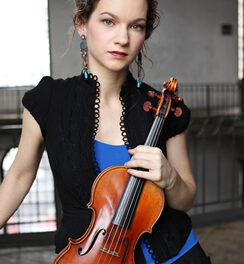At its quality web site, the North Carolina Symphony promised that the upcoming edition of the Duke Medicine Classical Series would be bold, exhilarating, romantic, and powerful. And indeed it would be safe to say that they delivered on all four counts at Meymandi Concert Hall. The program had been presented the evening before in Southern Pines. The third and final presentation was scheduled for the following evening, again in Meymandi Hall.
Guest conductor for the three programs was Carlos Miguel Prieto, a much-traveled and highly honored young native of Mexico. He serves as music director of the National Symphony Orchestra of Mexico, the Orquesta Mineria (Mexico), the Louisiana Philharmonic, and the Huntsville Symphony in Alabama. One becomes vicariously exhausted when reading about those tasks in addition to his manifold visiting engagements. So it’s at least a minor miracle that he was able to work in these appearances. His extraordinarily animated conducting style comes across as totally unaffected, rubbing off on the players to a magical degree.
The aforementioned “bold” quality perhaps manifested itself best in programming the opening Alberto Ginastera work, “Variaciones Concertantes” (1953). This piece comprises no fewer than nine variations and three other brief movements, featuring just about every instrument in a solo venture. It would serve as a worthy substitute for Britten’s “Young Person’s Guide to the Orchestra.” In the wondrous beginning theme for cello (Bonnie Thron) and harp (Anita Burroughs-Price), these acclaimed players set the mood in a manner fully “espressivo.” Special mention should go to the variation for oboe and bassoon, where Melanie Wilsden and John Pederson (respectively) swapped melody and harmony in such a blissful manner. Indeed, it is doubtless a source of orchestral pride that all the principals can display that lofty level of talent.
The familiar Suite from Copland’s Billy the Kid (1938) was a crowd-pleasing success all the way. Dancehall girls, cowboys, townspeople, posses, lawmen – they all appeared and faded. The “Gun Battle” segment was especially effective and startling. Laced throughout were snippets of arguably the Old West’s most appealing and heart-tugging song, “Goodbye Ol’ Paint, I’m a-Leavin’ Cheyenne.”
Anecdotal evidence suggested that not many listeners were familiar with the large work of the evening, Rachmaninoff’s “Symphonic Dances” (1940). It is said to have been his last orchestral effort, so the power and scope is certainly pure Rachmaninoff. It does not feature sustained and gorgeous melodies like, say, his Symphony No. 2. But the luxuriant orchestration leaves the listener fully sated. Unusual touches abound. At one point the piano and harp are prominent. Most unexpectedly is an exquisite saxophone solo midway during the opening “Non allegro” movement. The soloist was not identified, but his proficiency with the instrument made one wonder why it is not utilized more frequently in symphonic circles.
The program was billed on the tickets as an “Orchestra Showcase,” and a showcase it turned out to be. Of the promised qualities, “exhilarating” certainly could apply to the Copland and Rachmaninoff pieces, “romantic” definitely applying to the latter. Representing as these selections did the very finest from the mid-twentieth century, no one could possibly question their “powerful” properties. Here was an imaginative foray into “music appreciation” without any of the pedantic baggage that expression can sometimes carry.











